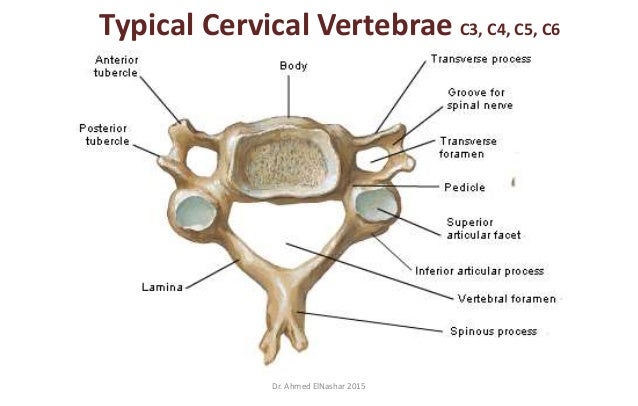All vertebrae even though they have different function, have certain features in common.
- Neural canal: This is the passage of the spinal cord.
- Neural spine: This project upward dorsally for the attachment of muscles.
- Trans verse processes: They project from the side of each vertebra for the attachment of muscles and ligament.
- Centrum : It is a solid piece of bone below the neural canal.
- Facet: This a small, smooth, flat or slight depressed on the bone usually in point of contact with another bone.
- Zygapophysis : These are articular surfaces for the articulation of successive vertebrae, They are grouped into two parts namely:
(a) Pre- zygapophysis facing inward and upward. (b) Post- zygapophysis facing outward and downward.
CERVICAL VERTEBRAE.
The cervical vertebrae are found in the neck region. The First vertebra is called atlas while the second one is called axis. The third to the seventh bones are similar and they are the normal cervical bones. The atlas allows the head to nod and it fits into the occipital condyles of the skull.
Characteristics of atlas.
- It has a large neural canal.
- It has a flat and broad transverse process.
- The neural spine is very short, in some cases it may even be absent.
- Centrum is absent.
- It has a vertebrarterial canal for the passage of blood vessels.

Characteristics of Axis vertebrae.
- It has a broad and flat centrum.
- It articulates with the atlas through odontoid process.

- It has a large flattered neural spine.
- The transverse process is reduced to pin- like structure.
- It has a vertebrarterial canal.
THORACIC VERTEBRAE
Thoracic vertebrae are found in the chest region.
Characteristics
- It has a long and prominent neutral spine which project upward and backward.
- It has a pair of short transverse processes.
- There is presence of demifacet and articular surfaces for attachment of ribs.
- It has a large neural canal.
- It has a large centrum.
Functions of the Thoracic vertebrae
- It aid the attachment of the ribs.
- It provides space for attachment of muscles of the shoulder and back to the neural spine.
- It assists in breathing along side with the ribs.

LUMBAR VERTEBRAE
The lumbar vertebrae are found in the upper abdominal region.
Characteristics
- It has a large flattened transverse process.
- It has a broad and flat neural spine.
- It has a large and thick centrum.
- It has well developed pre and post zygapophysis.
- It also have two extra- paired projections called anapophysis & metapophysis for attachment of abdominal muscles.
Functions of the lumbar vertebrae.
- The lumbar vertebrae provide attachment for abdominal muscles.
- They bear considerable weight of the body.

SACRAL VERTEBRAE
These bones are found in the lower abdominal region. In man, they are 5 in number and they are fused together to form the sacrum.
Characteristics
- It has a narrow neural canal.
- It has neural spine which is reduced to a small notch.
- It has a large centrum.
- The first sacral vertebra has a pair of transverse process which is large and wing like but the others are attached to the muscles of the back.
- The first sacral vertebrae has a small neural canal which gradually become narrower in the other vertebra.
They are joined with the pelvic girdle to provide support rigidity and strength.

CAUDAL VERTEBRAE
The caudal vertebrae are fused together is a solid mass of bone are found in the tail region.
RIBS AND STERNUM.
Twelve pairs of ribs and sternum form the rib cage in humans, the sternum is a single bone which consist of seven small bones. The ribs articulate with the thoracic vertebrae; however, in humans only the first ten pairs are attached to the sternum. The last two pairs remain free and are known as floating ribs
Functions
- The ribs and sternum protect the heart and the lungs.
- They assists in respiration.
Read our disclaimer.
AD: Take Free online baptism course: Preachi.com 